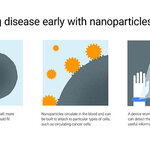Technology

Words are so 20th century. The 21st century could belong to brains communicating directly with each other.
Researchers have successfully replicated a direct brain-to-brain connection between pairs of people. In the newly published paper, which involved six people, researchers were able to transmit the signals from one person's brain over the Internet and use these signals to control the hand motions of another person within a split second of sending that signal.
The research team combined two kinds of noninvasive instruments and fine-tuned software to connect two human brains in real…

No need to say goodbye to the print book. Amy Johansson/Shutterstock
By Andrew Prescott, King's College London
“Analog” and “digital” are the two polar opposites of our modern world.
The word “analog” has become our catch-all term for what we see as slow, one-way and limited in functional possibilities; while “digital” is our synonym for the dynamic, interactive and fluid.
Analog is old; digital new. Paper has always been the epitome of the analogue: a physical medium which can receive, present and preserve information but otherwise remains static and fixed.
It’s our entrenched understanding…

Like coffee but your liberal guilt won't let you enjoy it if the energy to heat the water might have come from natural gas or nuclear energy?
There may be hope for the future. Researchers at Lancaster University have used a Raspberry Pi to determine the optimum time for a cup of tea in terms of impact on the environment - it only allows a kettle to boil when the University’s wind turbine is producing electricity. Windy Brew is the brainchild of Dr. Will Simm, Dr. Peter Newman, Dr. Maria Angela Ferrario and Dr. Stephen Forshaw.
It envisions a future where man does not reshape nature, but…

via: The Telegraph
By Jane Palmer, Genetic Literacy Project
Sometimes I think I’ve outsourced my consciousness to Google. Can’t remember something? Google it. Want to remember something? Google Doc it. Want to get noticed? Get on Google News. If Google ever does pull the plug it will take my career, my social life and my memories leaving me a mere shell of an intelligence thinking human being, such is my sad dependent state.
But if that isn’t enough, now Google has plans to infiltrate our bodies too, of course with an offer that is simply too good to refuse: early detection of cancer and…

Imagine a site where the lead developer supported the Discovery Institute, the Tea Party, the Mitt Romney campaign, Greenpeace, Joe Mercola, Just Label It, and various other political activist and anti-science groups.
Would you believe it was really neutral about science?
Perhaps. It depends on how many other people are involved in the project, but it would certainly bring a higher level of scrutiny.
That is the issue that has been facing a site called Truthy in the run-up to this election. Republican sites were all re-blogging each other about the Truthy project, which was created to analyze…

Modern biology has a problem - how to find meaning in the rising oceans of genomic data, such as the reams of cancer mutations that genome-wide studies are publishing every week. The challenge is finding efficient ways to parse the signals from the noise.
There are efforts to fuse statistical mechanics and a learning algorithm into a mathematical toolkit that can turn cancer-mutation data into multidimensional models that show how specific mutations alter the social networks of proteins in cells. From this, biologists can deduce which mutations among the myriad mutations present in cancer…

William Murphy/flickr
By: Alexander Hellemans, Inside Science
(Inside Science) -- Researchers around the world are studying how to destroy chemical and biological warfare agents without anyone getting hurt. A research group at the University of California, San Diego has demonstrated the ability to destroy dangerous agents, such as nerve gas and anthrax spores, with a recent new invention: self-propelled micromotors.
Micromotors can act as tiny nanotorpedoes that propel themselves through fluids using chemical energy. Ordinary micromotors consist of double layers of iron and platinum…

Antibodies that recognize and home in on molecular targets are among the most useful tools in biology and medicine - now those kinds of techniques are getting smaller and easier to produce in the form of nanobodies.
Antibodies are defensive proteins deployed by the immune system to identify and neutralize invaders. But their power can be harnessed in other ways as well, and they are used in biology and medicine for visualizing cellular processes, attacking diseased cells and delivering specific molecules to specific places.
Like their larger 'cousins', nanobodies can also be used for…

We should know by now - don't click that link. Bill Buchanan, Author provided
By Bill Buchanan, Edinburgh Napier University
A chain is only as strong as its weakest link. Computer security relies on a great number of links, hardware, software and something else altogether: you.
The greatest threat to information security is actually people. Why strive to defeat encrypted passwords stored in computers, when those computers' human users will turn them over willingly?
The technique is known as social engineering. It could be a phone call at your desk “from IT” querying problems with your login…

Source
My colleague, Tony Troxell, has a blog called Geeking in Indiana with the tagline, “Movies, Tidbits, and General Geekery from Around Indiana.” Tony explains the purpose of his blog here.
I should point out that I used the word “cosplay” in the title of this article, but Tony considers himself to be a “costumer” rather than a “cosplayer.” He explains the difference between the two here. According to Tony, “ ‘Cosplay’ is dressing in a costume and playing the character. You know, Costume + Playing The Character = Cosplay.” But wouldn’t that make just about everyone in the Society for…